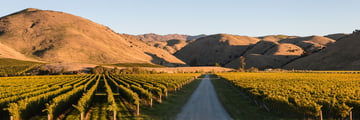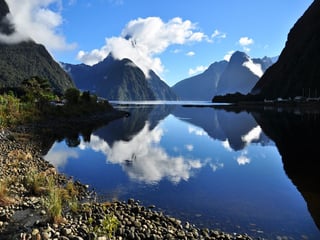When is the best time to travel to New Zealand?
New Zealand has it all, from glaciers, fiords and volcanoes to coastline, plains and forests. Made up of two islands, the country’s diverse geology and location in the South Pacific means it experiences varied weather throughout the year. So, when is the best time to travel to New Zealand? Whether you’re looking for a beach break, spring hike or winter snowsports, here’s a guide to New Zealand’s climate and when to visit.

What’s in this guide?
- Overview of New Zealand’s seasons
- Weather variations in the North and South Islands
- Visiting New Zealand in the summer
- Visiting New Zealand in the autumn
- Visiting New Zealand in the winter
- Visiting New Zealand in the spring
- When’s the best time to see flora in New Zealand?
- The best time to visit New Zealand wineries
- New Zealand wildlife migrations
- Top New Zealand holidays and events
Overview of New Zealand’s seasons
New Zealand receives over 2,000 hours of sunshine a year. The country sits on the Pacific and Australian tectonic plates which gives it astounding geological features, from geothermal springs to volcanoes. Generally, it’s best to visit New Zealand in the peak summer season, although the shoulder months of October, November, March and April are less crowded and still see plenty of sunshine. Visit in winter if you want to enjoy snowsports. New Zealand has four distinct seasons that are opposite to the Northern Hemisphere:
• Summer: December, January, February
• Autumn: March, April, May
• Winter: June, July, August
• Spring: September, October, November

As an island nation, New Zealand’s weather is influenced by the sea and has a mild, maritime climate with unpredictable weather. The top half of the North Island is subtropical in summer, with temperatures reaching 30 degrees and the weather generally gets colder the further south you travel. Expect snow from June to October in mountainous areas like the Central Plateau, Southern Alps, Canterbury and around Queenstown.
Rainfall in New Zealand averages between 640mm and 1,500mm annually and results in lush, green landscapes. The rain is mostly spread throughout the year but winter is the wettest season, apart from in the bottom of the South Island, which receives more rain in the summer. Westerly winds from the Tasman Sea bring heavy rain on the west coast, particularly on the South Island, making Fiordland one of the world’s wettest places. At its rainiest in January, Milford Sound receives an average 722mm of rain.

Weather variations in the North and South Islands
In Northland and the Bay of Islands, there’s a subtropical climate boasting hot summers, with Whangarei and even Auckland reaching 30 degrees. Winter in the north sees more unsettled weather with sea breezes and rain. Gisborne on the east coast has some of the most extreme North Island temperatures, up to 30 in summer and freezing in winter. The rest of the North Island has a milder climate, with the central area sheltered by high country. There are lake breezes around Taupo and Rotorua and as you head Southwest, there’s more erratic weather from the Tasman sea.
In the South Island, Queenstown, The Southern Alps and Canterbury receive lots of winter snowfall, especially on Mount Cook, the country’s highest peak. Snowsports are popular in these areas, with temperatures plunging below freezing. Aside from the mountains, the coldest spots like Invercargill lie on the southern coast. Summer is warm in the South Island, with temperatures in the high teens and 20s. Christchurch has even been known to top 30 degrees. In this region, rain falls year-round and the bottom half of the island experiences the wettest weather during the summer, predominantly on the west coast.
Summer: December, January, February
Average day temperature: 20–25 degrees
Average days of monthly rainfall: 7
Summer is the warmest time of year across New Zealand but it never gets muggy. With long, light days, this season is great for beaches, lakes, hiking, cycling and other outdoor adventures. The hottest weather is in February, when temperatures can reach 30 degrees in Northland, Auckland and Gisborne on the east coast of the North Island. The Christmas period is a busy time for domestic and international tourists, so advance bookings are essential. Look out for red, native Pohutukawa trees in full bloom.

Autumn: March, April, May
Average day temperature: 17-25 degrees
Average days of monthly rainfall: 11
Autumn is a cheaper, quieter time to visit and still benefits from long, sunny days with average temperatures ranging from 17-25 degrees in the north and 13-19 in the south. There’s a chilly nip in the air from mid-April, which can be welcome on one of the country’s Great Walks or while exploring cycle paths. Autumn provides golden foliage, top spots for leaf peeping include Hawke’s Bay, Mackenzie Country, the Southern Lakes region and Central Otago. Off-peak prices often apply for attractions in May, the coldest month.
Winter: June, July, August
Average day temperature: 12-16 degrees
Average days of monthly rainfall: 13
Winter brings New Zealand’s coldest weather, particularly in the South Island, with average temperatures in the single digits apart from in the warmer, top half of the North Island. The heaviest rainfall occurs in winter and many walking tracks and water sports are closed. The exception is the bottom part of the South Island, which is driest in winter. Winter is ideal for snowsports and the ski season typically runs from June to the first week of October. There are world-class ski areas in the North Island’s Central Plateau, the Southern Alps and around Queenstown and Canterbury, where there’s thick snow and freezing temperatures.

Spring: September, October, November
Average day temperature: 16-19 degrees
Average days of monthly rain: 11
Spring offers mixed weather, with cool, sunny days and spring showers. This is a good time to experience New Zealand’s nature, with waterfalls at their fullest as the mountain snow melts, offering exciting white-water rafting. New Zealand’s cycle trails, Great Walks and vineyards are popular in spring and it’s the height of lambing season. Many visitors come to see the flowers and trees in full bloom, with celebrations like the Alexandra Blossom Festival in September. There’s still some snow in high areas of the South Island in spring and brisk winds, which can be extremely strong in Wellington.

When’s the best time to see flora in New Zealand?
New Zealand is a natural paradise and over 20 percent of the country is covered in national parks, reserves and forests. Native flora flourishes in the country’s sunny, wet conditions, with evergreen forests filled with totara, beech and Giant Kauri trees. Spring is the best time to see nature in full bloom. September brings cherry blossoms, which you can see at the Christchurch Botanic Gardens and Alexandra Blossom Festival, which takes place in the last week of September. For spectacular autumn foliage in April and May, the best regions include the Mackenzie Country, Hawke’s Bay, the Southern Lakes Region and parts of Central Otago.
The best time to visit New Zealand wineries
February to April is harvest season and a great time to visit New Zealand wineries, with grapes at their peak in March. The Classic New Zealand Wine Trail includes 80 percent of the country’s wine regions, with tastings available at renowned wineries in areas like:
• Napier
• Hawke’s Bay
• Wairarapa
• Wellington
• Picton
• Marlborough

New Zealand wildlife migrations
New Zealand is surrounded by waters rich with marine life such as hector, dusky and bottlenose dolphins. It’s possible to see whales all year-round in multiple locations but Kaikoura on the South Island’s north-east coast is known as the country’s whale-watching capital. You can take boat tours from here to see sperm whales throughout the year, while migrating whales like the humpback, pilot and southern right are visible between June and August. Orcas even stop to feed in Kaikoura from November to February. The Bay of Islands is another top whale watching spot, offering sightings of orcas, dolphins and migrating whales, especially between April and July.
There are up to 60,000 fur seals in New Zealand, which you can see in destinations like Cape Palliser and Castlepoint in the North Island and Tonga Island, Kaikoura and Abel Tasman National Park in the South Island. Breeding season falls from mid-November to late January and it’s possible to spot cute fur seal pups from April to October. Mid-march or mid-October is the optimum time for spotting migratory birds in New Zealand in places like Farewell Spit. The Otago Peninsula is home to seals, penguins and albatross, with birds arriving from September to November for nesting and breeding and chicks hatching in late January.

Top New Zealand holidays and events
You need to be mindful of New Zealand's summer and Easter school holiday dates, particularly given the higher demands for accommodation during these times. Here are some other public holiday and event details.
• Waitangi Day – Feb 6th
• Wellington Fringe Festival – for three weeks in February and March
• Hokitika Wildfoods Festival – March
• Pasifika Festival – March
• Anzac Day – April 25th
• Dunedin Winter Carnival – June, on the Saturday closest to winter solstice
• Matariki, the Maori-New Year celebrated across the country – June or July
• New Zealand International Film Festival – July and August
• New Zealand Fashion Week – end of August
• Alexandra Blossom Festival – end of September
• Auckland Heritage Festival – September and October
• Canterbury A&P Show – November

More Inspiration
Recommended holidays












